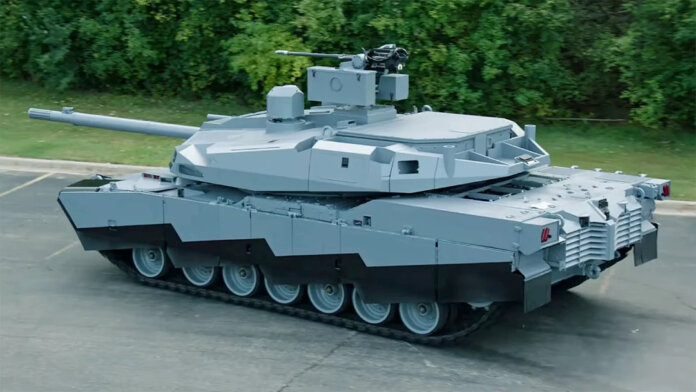General Dynamics Land Systems is presenting a preview of what the next-generation Main Battle Tank may look like and its capabilities in its Abrams-X technology demonstrator being debuted at AUSA (Booth 800).
Tim Reese, Director General Dynamics AUSA US Business Development, shared that “Abrams-X represents what is possible today that could be incorporated into a possible follow-on to the latest current M1A3 SEP V3 and V4 updates”.
This future design replaces the manned turret and locates the entire crew of three (reduced by one crewman) forward in the hull. This move is facilitated by the incorporating an automatic loader for the XM-360 derived 120mm main gun with a ported muzzle brake. Observation and targeting relies on two 360 degree panoramic roof mounted sights which include multi-sensor next generation day, thermal, and laser ranging.
It is likely the demonstrator takes advantage of digital networking and integration of platform sensors and data interlacing to offer crewmen , access to panoramic situational awareness including helmet mounted displays. Given the common crew location and the digital backbone of the KATALYST Next Generation Electronic Architecture (NGEA) information from the sights and, in fact, all sensors and data inputs can be accessed by each crewman.
“KATALYST”, Reese explained, “is designed as an open architecture that can more easily accept upgrades and the incorporation of new systems and technologies into the platform as they become available. It also allows the platform to act as a key node on a networked battlefield and to integrate with manned and unmanned, both ground and air assets.
An obvious lethality upgrade over current MBT’s is the mounting of a 30mm chain gun remote weapon station on the turret roof rather than the traditional .50 heavy machine gun. The XM914 30mm not only enhances the ability to engage a range of soft and light armored targets but, using Programable Airbust ammunition, offers both a more effective response to anti-tank teams and a counter-UAS capability.
In addition, ABRAMS-X uses a modular configuration which can incorporate situational-awareness enhancements, threat-detection/warning, counter-measures, active-protection and other sub-systems. The approach permits the application of various capabilities including the adoption of future technologies with relative ease.
Another major change in ABRAMS-X is the adoption of a hybrid power pak. It employs an advanced Cummings diesel engine at the primary power source with the addition of electric batteries in a parallel configuration. Here electric supplies power in low demand periods like stationary operation, in silent watch as well as offering exportable power. Diesel drives the tank with electric available to augment power needs at high demand periods. The vehicle as configured meets current range demands with 50 percent less fuel but the design could be altered to increase this range. The new power approach also contributes to reducing the overall tank weight, reversing a trend in MBT’s which potentially impacts on their suitability where transportation infrastructure, particularly roads and bridges, is less developed.
Reese suggested “Our objective in presenting our technology demonstrators is to provide the Army with a true physical hardware representation that they can see, touch, and evaluate representing capabilities that can be provided today.”
by Stephen W. Miller














